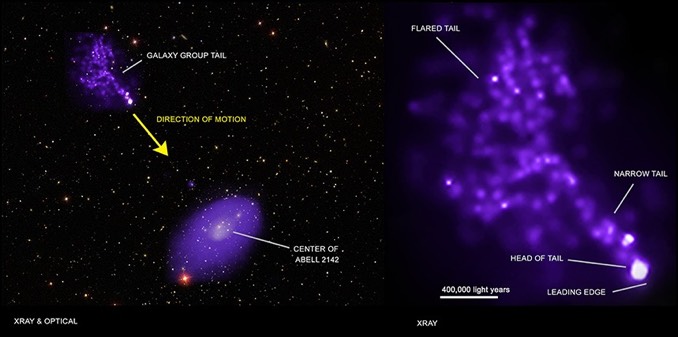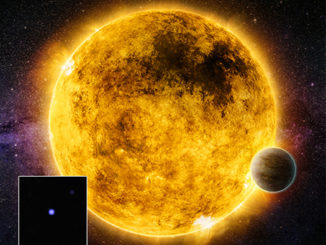
Galaxy clusters, containing hundreds or even thousands of individual galaxies embedded in vast clouds of hot gas and dark matter, are the largest gravitationally-bound structures in the universe. They can grow to truly enormous size by pulling in surrounding material – including other galaxies – with their collective gravity.
NASA’s Chandra X-ray Observatory has provided a detailed look at a handful of galaxies doing just that, falling directly into the Abell 2142 galaxy cluster, leaving a million-light-year-long trail of million-degree hot gas in its wake. In the abstract of a paper describing new observations, the in-falling galaxies are described as “the poster child of such an accreting group” and “an ideal target to study the astrophysical processes induced by structure formation.”
Abell 2142 is one of the most massive structures in the known universe, stretching some six million light years across and containing hundreds of galaxies. It is located in the constellation Corona Borealis some 1.2 billion light years from Earth. The purple glow seen in these images represents X-ray emissions from extremely hot gas enveloping the cluster, but the gas is thought to extend much farther.

The group of galaxies being pulled in toward the centre of the cluster features four bright members at the head of the long tail, tightly grouped and visible in X-rays and at optical wavelengths. Two of those galaxies feature fast-growing supermassive black holes. As the group moves inward, some of the hot gas surrounding them is being stripped away, forming a relatively straight and narrow tail that extends away some 800,000 light years.
Researchers say the shape of the tail suggest magnetic fields “draped around it are acting like a shield to contain the gas,” according to a release describing the observations. “Beyond about a million light years, the tail flares and becomes irregular. This may mean turbulence in the galaxy cluster’s hot gas is stronger in that area, helping to break down the effect of the magnetic shield.”
In the more distant regions of the tail, asymmetries could be caused by outbursts from supermassive black holes in one or more galaxies or from earlier galaxy mergers within the group.



